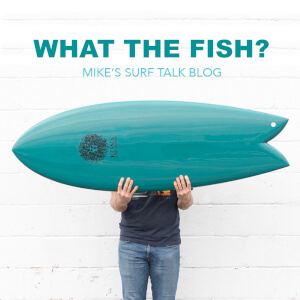The legacy of the Fish surfboard is the most baffling of all the shapes out there. In it’s fifty plus year existence, uninitiated surfers are still confused by a first look at the Fish. The shape of the board appears to look like it has previously been a longboard that was snapped in half and added a few fins to it. In reality, that is not too far from the truth.
Kona Team Rider Jake Mckenna on the Kona Retro Fish.
Like many things in the surfing encyclopedia, the Fish evolved from older concepts. The Fish combines aspects of both a short and a longboard. Surfboard shaper Steve Lis is credited for creating the Fish surfboard in 1967 in which he carved out of a longboard that was broken in half. Lis, a kneeboarder, who traditionally surfed shortboards on his knees, looked at the broken board and thought the additional width from the front of the broken longboard would be more comfortable to ride. With that being said, this board was first developed as a kneeboard, but Lis took it a step further by splitting the tail. This technique created the extra width needed to support the fins to make the shape a true surfboard.
Unfortunately, due to the rivalry between surfers and kneeboarders, nobody noticed the importance of this new-fangled surfboard that would make a lasting impression on the surfing industry for several years. The Fish started to make an impact in 1972 when Jim Blears and David Nuuhiwa rode the surfboard to victory at the Huntington Beach World Championships. Due to the laid back personality of Steve Lis, he never capitalized on these victories. Lis had also never patented the design or made any attempts to cash in on the board’s success. In an entirely selfless act that is now considered the greatest gift to surfers everywhere, Lis shared the design with local shapers.
Steve Lis Fish Template from Surfer Magazine Design Forum.
The broad swallow tail, straight rocker, and the placement of the fins assist with rail to rail transitions. The increased volume from the wide, thick body catches mushy waves at the local break and helps with paddling. Plus, this thing cooks! It’s super fast on small and large waves which only adds to the misconception of the board. The Fish is tried and true in a variety of surfing conditions. The main benefits of riding a Fish are catching less than ideal waves with more speed, additional stability, quick and easy to paddle, and easier transitions than a longboard.
The fish lineup at Kona Board House in Wildwood, New Jersey.
Through the late seventies and early eighties, the Fish was primarily ridden in San Diego, California. Sometime in the early eighties, shapers modified Lis’ original Fish design. A three-finned version was created that was so popular, the original Fish design became obsolete. It wasn’t until the late nineties when surfers like Donavon Frankenreiter and Dave Rastovich realized that the design of the original fish was not only really fun but is still revolutionary in the speed and flow department, allowing the original design make a comeback.
You know what? There’s an awesome documentary Joseph Ryan made a couple years ago that gives you an in-depth look at the history and design of the Fish surfboard and how the board has impacted the culture. Check out the trailer below.
Fish: The Surfboard Documentary Trailer
Here at Kona, we offer three versions of the Fish surfboards. We recommend our Twinner Fish surfboard to be the closest shape to the original Fish. It is perfect for all conditions and levels and great for young surfers transitioning from a beginner board. While you’re at it, check out our Kai and Retro Fish models that blend modern elements with the traditional design to increase the boards performance.
You can check the Fish surfboards for sale at Kona here:
Follow The Waves.





